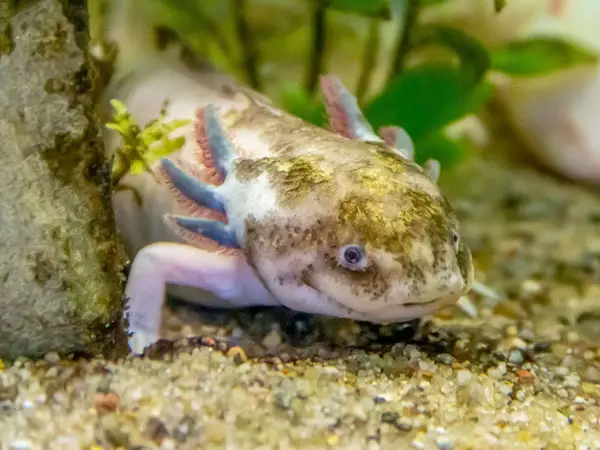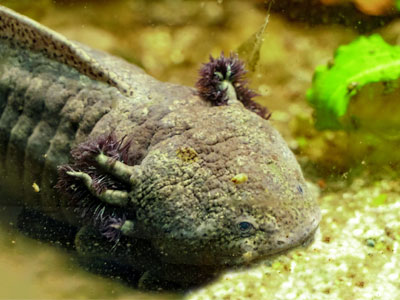One of the greatest phenomena when owning an axolotl is that there is a possibility that your axolotl will morph into a salamander. It happens very rarely, but when it does, it’s usually a complete transformation that your axolotl can survive or not.

Sometimes, your axolotl will survive the transformation, or it could not. When you see the morphing happening, it’s important to act appropriately. If you leave the conditions the same, it might lead to death.
The new axolotl, or the salamander, is not an aquatic animal, and it will demand air to survive; additionally, it will need a place to walk in, as it won’t stay in the water. Some of the symptoms of transformation can be similar to other symptoms, but when your axolotl is morphing, it’s usually pretty clear to see.
Here is everything about axolotl transformations, how to care for axolotls when they transform, why it happens, and much more. What to do if axolotl morphs?
How do You Know If the Axolotl is Morphing?
The first step in taking action here is actually recognizing whether your axolotl is really morphing or not. Usually, the signs will be pretty clear.
It’s important to recognize the signs of transformation in the first place. If you identify the same signs, you should prepare everything for the axolotl to complete the transformation.
So what are the signs of your axolotl morphing?
- The axolotl will have bulging eyes.
- The tail and dorsal fin will be receding.
- The eyelids will start to form.
- Gills will become extinct, and they might be removed altogether.
- Axolotl’s legs will start to become thicker and larger, as the salamander will need them to walk around.
- You might also notice several changes in behavior, and the color of the animal will start to change.
- Once the transformation is drawing to a close, the salamander will struggle to swim and will reach for the surface in order to get oxygen.
So these are the signs of transformation, and they are pretty clear. The axolotl is morphing into a salamander, which is a totally different animal. The axolotl is an aquatic animal, and they are the product of a partial transformation into a salamander.
In some cases, the complete transformation might be triggered, resulting into a transformation into a salamander. And once it forms, it’s a different animal altogether.
A salamander will prefer to live on the land, while the axolotl is an aquatic animal. Also, the salamander will walk around, while the axolotl has some capability to move around in the water. The gills will be gone, and the legs will be much stronger. The whole system of the animal will change.
When you notice the signs, it’s important to act fast.
What to do if the Axolotl Starts Morphing?
Once you’ve recognized the signs of transformation, you should take action. To be more precise, you should allow your axolotl to morph completely.
This includes giving them the proper conditions to survive once they morph. If they are caught in the water, they might die as the salamander is incapable of living in the water. You will also need to prepare the environment for the salamander.
Here are the steps you need to take when the axolotl starts morphing.
Prepare a Place for the Axolotl to Morph
The first step should be to provide the axolotl with a proper place to transform. The axolotl, once it transforms, won’t be able to swim, as the tail and the dorsal fin will become much smaller or will be gone. Salamanders are not aquatic animals.
With this in mind, get a shallow tub or even a spare aquarium ready. Fill it with as much water so that the axolotl is sticking out of it. During the transformation, it will need plenty of air.
It might also not be a bad idea to have some dry land on the other side of the aquarium. So you can have some water, and some “land” on the other side of the tank. It could be rocks, larger stones, or even sand – whatever you find in your home.
Another thing you should provide is a hiding spot to help the axolotl feel more secure when morphing. You can put in something like a Styrofoam cup cut in half, or perhaps even hide.
As the salamander transforms, it will be perfectly capable of walking and climbing walls, so it might scale up the container wall and leave it once it transforms. That’s why it’s important that you confine it in some way; putting a lid on is important here. But the lid should have holes for the air to come in. If it doesn’t have holes, make them.
Have Another Container at the Ready
When the axolotl is morphing and you have set everything for it, this will buy you some time to buy everything necessary for the new salamander to live.
If the transformation was sudden, you can improvise. Have a separate container at the ready, and put in some paper towels and a hiding spot in it. You’ll need to replace the towels every day. This container with paper towels might be used as a “monitoring” container. Keep the axolotl there for two weeks, and wait and see.
If, after two weeks, the salamander is ok, you can buy the things that you need to own a salamander.
The ideal thing, however, is to buy everything necessary for the salamander. Here’s what you’ll need:
- A vivarium of 20 gallons or more.
- Some Eco Earth soil, or towels for the substrate.
- Rocks and other decorational pieces that should be larger than the animal’s head.
- Food: live foods (crickets, earthworms, slugs, waxworms), frozen foods.
Here’s how to set up the tank.
At the bottom, you should have either towels or soil. In any case, it should be slightly moist, as the salamander will absorb the moisture from the ground, as well as the air. Decorate the vivarium with rocks that are larger than the salamander’s head. As these salamanders will like to dig into the soil, make sure they aren’t capable of doing that.
Also, buy the appropriate foods. These foods should consist of live earthworms or crickets, or other foods that we described above. Feed the salamander twice a week or more.
The conditions of the vivarium are also important. The temperatures should always be between 65 and 72 degrees Fahrenheit (18.3-22.2 degrees Celsius). It’s not a bad idea to place a bowl of water into the tank for the salamander to hydrate.
Why Does an Axolotl Morph?
Not much is known about the reasons for transformation, although there are some possible reasons. Sometimes, it just happens naturally. It might be largely down to the genetic makeup of the axolotl, and it’s something that is premeditated and can’t be stopped.
In other cases, the transformation happens due to various reasons.
It might be due to poor water conditions. If you don’t want transformation to happen, it might be wise to keep the parameters in check. Bad water parameters and wrong temperatures might trigger the transformation.
Another reason for morphing is an overcrowded tank. It’s a common reason, although it’s unlikely that many owners have an overcrowded tank with axolotls in the first place.
How Long will a Morphed Axolotl Survive?
The lifespan of the transformed animal can vary quite significantly. If the animal survives during the transformation, of course. There is a chance that the axolotl will die during the transformation, and in those cases, there’s not much you can really do.
The potential lifespan of the animal also depends on the conditions that caused the transformation, and the age of the axolotl.
If the axolotl is still juvenile, then there’s a much higher chance of the animal surviving for significantly longer. It can even reach up to 15 years, provided that it has been cared for properly, of course.
If the axolotl is slightly older when it transforms, then there’s a bigger likelihood that it will survive for a shorter amount of time. It might be a couple of years, or even less, in some cases.
This aspect is also an unknown in the axolotl world, though. The reports from various people vary; some have had success with the morphed animals, while others have seen theirs died after just a few hours.
Conclusion
An axolotl transformation is truly a wonder of the nature. It’s a phenomenon that happens very rarely, but it happens.
In some cases, there’s just nothing you can do; all you can do is accept it and enable the animal to survive the transformation by setting up the tank properly.
In other cases, it’s better to take preventative measures in the first place. This includes keeping good care of the axolotl, having proper water conditions, and the parameters should always be within ideal ranges.
If the transformation does happen, though, don’t worry; just make sure you give the animal every chance to survive.




